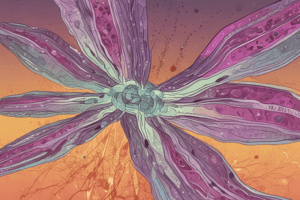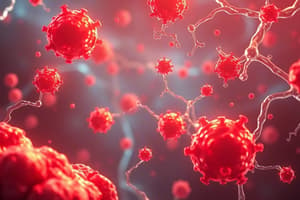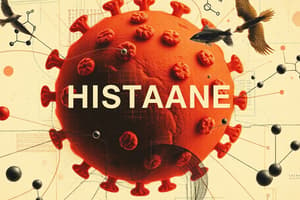Podcast
Questions and Answers
A researcher is investigating novel therapies for asthma. Targeting which of the following mediators would MOST directly address the bronchoconstriction characteristic of asthma?
A researcher is investigating novel therapies for asthma. Targeting which of the following mediators would MOST directly address the bronchoconstriction characteristic of asthma?
- Platelet-activating factor (PAF), because of its role in platelet aggregation and clotting.
- Leukotrienes, specifically LTD4 and LTE4, known for their bronchoconstrictive effects. (correct)
- Prostaglandins, particularly PGE2, due to their vasodilatory properties.
- Histamine, due to its role in immediate hypersensitivity reactions.
A patient presents with hereditary angioedema (HAE) due to a C1 inhibitor deficiency. Which of the following mechanisms BEST explains the swelling and pain associated with this condition?
A patient presents with hereditary angioedema (HAE) due to a C1 inhibitor deficiency. Which of the following mechanisms BEST explains the swelling and pain associated with this condition?
- Excessive bradykinin production due to uncontrolled activation of the kinin system. (correct)
- Uncontrolled activation of the complement system causing direct cell lysis and inflammation.
- Increased histamine release from mast cells, leading to vasodilation and increased vascular permeability.
- Overproduction of prostaglandins resulting in sensitized nerve endings and pain.
A researcher is studying the effects of a new anti-inflammatory drug. They observe that the drug significantly reduces pain and fever in animal models. Which of the following mechanisms of action is MOST likely responsible for these effects?
A researcher is studying the effects of a new anti-inflammatory drug. They observe that the drug significantly reduces pain and fever in animal models. Which of the following mechanisms of action is MOST likely responsible for these effects?
- Inhibition of cyclooxygenase (COX) enzymes. (correct)
- Antagonizing the effects of platelet-activating factor (PAF).
- Blocking the synthesis of leukotrienes.
- Inhibition of histamine release from mast cells.
Following a severe burn injury, a patient experiences significant erythema, swelling, and pain at the site of the burn. If a drug could selectively inhibit the effects of bradykinin in the injured tissue, which of the following outcomes would be expected?
Following a severe burn injury, a patient experiences significant erythema, swelling, and pain at the site of the burn. If a drug could selectively inhibit the effects of bradykinin in the injured tissue, which of the following outcomes would be expected?
A patient with a history of severe allergic reactions experiences anaphylaxis after being stung by a bee. Which of the following mediators is MOST directly responsible for the systemic vasodilation and increased vascular permeability leading to hypotension in this patient?
A patient with a history of severe allergic reactions experiences anaphylaxis after being stung by a bee. Which of the following mediators is MOST directly responsible for the systemic vasodilation and increased vascular permeability leading to hypotension in this patient?
A researcher is investigating the role of chemokines in directing leukocyte migration during an inflammatory response. Which of the following BEST describes the function of chemokines in this context?
A researcher is investigating the role of chemokines in directing leukocyte migration during an inflammatory response. Which of the following BEST describes the function of chemokines in this context?
A patient undergoing treatment with ACE inhibitors for hypertension develops a persistent dry cough. Which of the following mechanisms BEST explains this side effect?
A patient undergoing treatment with ACE inhibitors for hypertension develops a persistent dry cough. Which of the following mechanisms BEST explains this side effect?
In the context of bacterial pneumonia, macrophages are activated and release various cytokines, including IL-1 and TNF-α. What is the MOST direct mechanism by which these cytokines induce fever?
In the context of bacterial pneumonia, macrophages are activated and release various cytokines, including IL-1 and TNF-α. What is the MOST direct mechanism by which these cytokines induce fever?
A researcher is developing a novel therapy to prevent the formation of atherosclerotic plaques. Targeting which of the following mediators would MOST directly address the role of platelets in this process?
A researcher is developing a novel therapy to prevent the formation of atherosclerotic plaques. Targeting which of the following mediators would MOST directly address the role of platelets in this process?
A 25-year-old patient with no prior history of illness develops a severe systemic inflammatory response following a bacterial infection. The patient's symptoms include widespread vasodilation, increased vascular permeability, and signs of shock. Which of the following mediators is MOST likely contributing to the patient's condition?
A 25-year-old patient with no prior history of illness develops a severe systemic inflammatory response following a bacterial infection. The patient's symptoms include widespread vasodilation, increased vascular permeability, and signs of shock. Which of the following mediators is MOST likely contributing to the patient's condition?
Flashcards
Histamine
Histamine
Found in mast cells, basophils & platelets causing vasodilation, increased vascular permeability, & endothelial activation.
Prostaglandins
Prostaglandins
Produced by mast cells & leukocytes and cause vasodilation, pain, and fever.
Leukotrienes
Leukotrienes
Secreted by mast cells & leukocytes, increase vascular permeability, chemotaxis, leukocyte adhesion & activation.
Cytokines (TNF, IL-1, IL-6)
Cytokines (TNF, IL-1, IL-6)
Signup and view all the flashcards
Chemokines
Chemokines
Signup and view all the flashcards
Platelet-Activating Factor (PAF)
Platelet-Activating Factor (PAF)
Signup and view all the flashcards
Complement System
Complement System
Signup and view all the flashcards
Kinins (Bradykinin)
Kinins (Bradykinin)
Signup and view all the flashcards
Study Notes
Chemical Mediators of Inflammation
- These substances initiate and regulate inflammatory reactions.
- Understanding the principal mediators, their source, and actions is crucial.
Histamine
- Source: mast cells, basophils, and platelets.
- Actions: vasodilation, increased vascular permeability, and endothelial activation.
- Clinical relevance: seen in asthma and allergies.
- Stored in granules within mast cells, particularly around blood vessels and vascular channels.
- It is released early during inflammation, leading to vascular permeability.
- Rapid response mediator that starts acting within seconds.
- Stimuli for release: tissue injury, allergens, complement proteins (C3a, C5a), neuropeptides, and cytokines.
- Platelets take up and store histamine from the plasma via histamine transporters, without synthesizing it themselves.
- Platelets release stored histamine through granule exocytosis, contributing to vascular changes during injury repair, hemostasis, and inflammation.
- Contributes to fibrin deposition, wound healing, and revascularization.
Prostaglandins
- Source: mast cells and leukocytes.
- Actions: vasodilation, pain, and fever.
- Increased levels contribute to menstrual pain.
- Blockers exist and will be covered in pharmacology.
- Generated by the action of COX-1 and COX-2 enzymes in local tissues.
- Blocking COX-1 and COX-2 reduces pain and inflammation.
- Vasodilation helps immune cells reach sites of injury or infection and contributes to redness and warmth at the affected site.
- PGE2 sensitizes pain receptors, contributing to hyperalgesia, while also acting on the hypothalamus to increase the body’s temperature set point, leading to fever.
- Stimuli for release: cyclooxygenase (COX-1 & COX-2) activation by mechanical or chemical injury, infection, hypoxia, inflammation, and cytokines (TNF, IL-1).
- Enable bacteria to enter the lungs
- Macrophages TLRs recognize bacterial components , releasing IL-1, TNF, IL-6 (cytokines) into circulation and signal the hypothalamus to increase prostaglandin (PGE2) production → Fever.
- Vasodilation → Redness and warmth.
- Sensitization of pain receptors → Body aches.
Leukotrienes
- Source: mast cells and leukocytes.
- Actions: increased vascular permeability, chemotaxis, leukocyte adhesion, and activation.
- Increased vascular permeability leads to mucosal edema and airway narrowing.
- LTB4 is a potent chemoattractant for neutrophils, eosinophils, and monocytes.
- Increased expression of adhesion molecules on blood vessel walls by white blood cells, priming and improving their ability to phagocytose pathogens.
- Triggered by allergen exposure, infections, and cytokine stimulation (TNF, IL-4, IL-13).
- Derived from arachidonic acid through the action of the 5-lipoxygenase (5-LOX) enzyme.
- Play a key role in inflammation, allergic reactions, and immune cell recruitment.
- Cysteinyl leukotrienes cause contraction of endothelial cells lining blood vessels, creating small gaps that allows plasma proteins, immune cells, and fluid to exit the bloodstream and enter tissues.
- Stimulates mast cells → Histamine and PAF are released.
- Effects of Leukotrienes: Bronchoconstriction , increased Mucus Secretion, and Eosinophil recruitment which lead to prolonged inflammation.
Cytokines (TNF, IL-1, IL-6)
- Source: macrophages, endothelial cells, and mast cells.
- Local action: endothelial activation.
- Systemic actions: fever, metabolic abnormalities, hypotension (may lead to shock).
- TNF attracts leukocytes to areas of inflammation
- Medications that block TNF are used in inflammatory bowel disease because they prevent neutrophils from entering the mucosa of the colon in Ulcerative Colitis and Crohn’s Disease.
- TNF-α, IL-1, and IL-6 key pro-inflammatory cytokines released during injury, infection, or immune activation, leading to inflammation, fever, metabolic changes, and septic shock.
- Promote neutrophil recruitment and macrophage activation, intensifying inflammation.
- Excessive levels causes chronic inflammation and is seen in diseases like rheumatoid arthritis and inflammatory bowel disease (IBD)
- Act on the hypothalamus, increasing production of prostaglandin E2 (PGE2) which raises the body's set point for temperature, causing fever.
- TNF-α and IL-6 increase muscle and fat breakdown to provide energy for immune cells which suppresses appetite by acting on the brain
Chemokines
- Source: leukocytes and activated macrophages.
- Actions: chemotaxis and leukocyte activation.
- Act primarily as chemoattractants for specific types of leukocytes.
Platelet-Activating Factor (PAF)
- Source: leukocytes and mast cells.
- Actions: vasodilation, increased vascular permeability, leukocyte activation, chemotaxis, and degranulation.
- Factors cause attraction of leukocytes, increased vascular permeability, and systemic effects like fever and hypotension.
- Stronger vasodilation & vascular permeability than histamine which leads to Leukocyte chemotaxis and activation.
- Stimulates platelet aggregation and degranulation, whilst also inducing bronchoconstriction.
- Released by: inflammation & injury, IgE-mediated reactions, bacterial endotoxins and complement activation.
- Contributes to bronchoconstriction and vasodilation in allergic conditions and is being investigated as potential treatments for asthma and allergic rhinitis to block.
- Involved in platelet aggregation and the formation of atherosclerotic plaques, contributing to the development of cardiovascular diseases
- Actions on vasodilation, increased vascular permeability, and leukocyte activation contribute to the hypotension and organ dysfunction seen in septic shock.
- Enhances the delivery of immune cells, increases oxygen and nutrient supply to tissues during inflammation or infection.
- Interacts with PAF receptors on leukocytes, triggering their activation and leads to directed movement toward higher concentrations of PAF near the site of injury
- Stimulates the degranulation of various immune cells, including mast cells and platelets, leading to the release of pre-stored mediators which increases vascular permeability, recruits immune cells, and further enhances the inflammatory response.
Complement System
- Source: Plasma proteins produced in the liver.
- Actions: leukocyte chemotaxis and activation.
- Complement complex: provides direct killing for microbes and other invaders.
- Functions in host defense mechanisms against microbes.
- Involved in pathological inflammatory reactions.
Kinin System (Bradykinin)
- Source: Plasma proteins produced in the liver.
- Actions: increased vascular permeability, smooth muscle contraction, vasodilation, and pain.
- High-molecular-weight kininogen activates prekallikrein and Factor IX.
- Kallikrein activates Hageman Factor (Factor XII).
- Bradykinin is produced by activated endothelial cells via the Kinin-Kallikrein system.
- Strongly increases vascular permeability , causes pain and induces smooth muscle contraction in some tissues.
- Vasodilator via nitric oxide and prostacyclin.
- Activated by: Hageman factor and tissue damage, clotting, or complement activation.
- HMWK is crucial in activating prekallikrein and Factor XI
- Tissue Injury or Activation of Factor XII increases Kallikrein which cleaves HMWK → leading to the release of bradykinin, which is a potent vasodilator, that contributes to inflammation vascular permeability and pain.
Clotting System (Factor XII / Hageman Factor)
- Hageman Factor (Factor XII) plays a role in the clotting cascade.
Mediator Action Timings
- Histamine and PAF act first in acute allergic/inflammatory reactions.
- Bradykinin and Prostaglandins are key for pain and vasodilation in tissue injury.
- Leukotrienes are major players in bronchoconstriction (asthma).
- PAF links inflammation and clotting, seen in sepsis.
- Cytokines sustain chronic inflammation in autoimmune diseases.
Studying That Suits You
Use AI to generate personalized quizzes and flashcards to suit your learning preferences.




